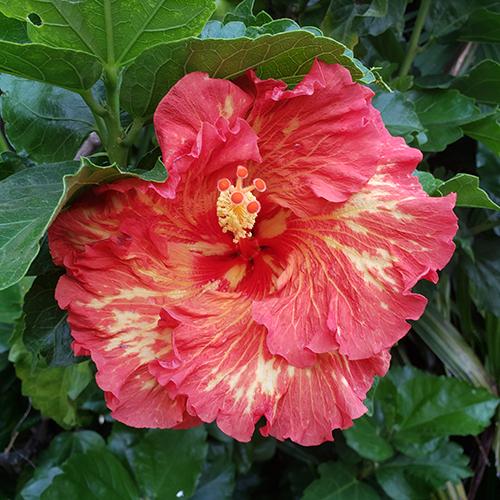
Benefits of Hibiscus
Hibiscus helped save our puppy We found a pedigree Golden retriever for sale for $50 in the local paper. At the time, they were selling

One single-celled organism, available as a whole, natural, wild food may well be the answer to many of the problems facing us in the world today.

In the process, millions of tons of mineral-rich volcanic ash was deposited on the area which drains into Upper Klamath Lake, creating a perfect spawning ground for the blue green algae, Aphanezomenon flos aquae, that flourished there, soaking it all up like a giant organic sponge.

So rich, in fact, is this natural fertilizer that the annual algae bloom, over two hundred million pounds, makes Upper Klamath Lake one of the most prolific biomass producing areas in the world.

The lake freezes every year killing most of the algae which settles to the lake bottom to compost with the significant amount of bird droppings deposited by the myriad of birds that visit. This compost is thirty five feet deep in some places.
The algae has adapted to take advantage of the two abundant sources of nourishment in Upper Klamath Lake, high desert solar energy from the sun, and the nutrient-rich sediment in the lake.
It operates a little parachute to rise to the top of the lake to feed on sunlight, then returns to feed on the bottom. Unlike soil-based agriculture, a nutrient-rich aquatic environment provides optimum nutrient exchange.
Rather than commercial crops competing for the few remaining nutrients left in our farmlands, Upper Klamath Lake algae have sixty times more nutrients than they need to fulfill their nutritional requirements.
They represent a life form living in abundance.

Our chemically-based agricultural system produces foods that are little more than a hollow shell, often containing more chemical fertilizer and pesticide residues than nourishment.
A can of spinach serves as the example for iron availability in commercial agriculture. One can of spinach in 1940 contained as much as seventy five cans today!
But where were the soils at in 1940? In the late 30′s, the United States Department of Agriculture released a report indicating that our soils were virtually bankrupt of minerals.
Cells depend on minerals to facilitate chemical reactions necessary for the production of vital hormones and other chemicals, such as serotonin.
Magnesium, zinc, and iron are important in the treatment of mood swings because they help the muscles relax, reducing cramping and pain that lower serotonin levels.
When I started adding blue green algae to my daily supplementation I was amazed at how much of a mood elevator it was!

The missing taste in tomatoes are minerals, ground up pieces of the Earth.
Chemical agribiz doesn’t contribute minerals, so as crops gobble up the minerals year after year, where are they going to come from?
Because this flavor is missing in most of our food, we add flavoring agents, like MSG, to placate our taste buds.
But inside, there is a growing hunger for elements vital to our continued health and well being. We call it false hunger. For we surely get enough to eat, and yet remain deficient.
Even organically grown produce may not contain all the important trace minerals we need to maintain optimal health.
In fact, the natural wild-growing blue green algae in Upper Klamath Lake may be one of the only remaining expressions of nature’s balance and abundance remaining in this developed world.
Besides a storehouse of vitamins and minerals, it contains significant amounts of beta carotene and other carotenoids, chlorophyl, and an amino acid profile almost identical to human breast milk.

A few grams of freeze dried algae will not replace a diet of organically grown whole foods. However, by supplying the necessary trace minerals, it enables us to absorb and utilize the mineral factors in our food.
When it comes to maintaining a healthy diet, nature’s first food, algae, may be our best hope.
For more information about this natural superfood or how to add it to your daily diet call 619 224 1268 or contact Jane via email at [email protected].
For info about other superfood nutraceuticals we enjoy and recommend, click here.
Teaching comprehensive holistic education since 1985.
We are currently offering interactive hybrid courses including Herbal Fundamentals, Energy Healing, Aromatherapy and Clinical Herbology
Hybrid means you may choose to participate in each individual class in the hybrid course online or in person.
All of our products are made with love from organic, all-natural and ethically sourced ingredients.
We began making and perfecting our own herbal remedies more than thirty years ago and offer our favorite products for purchase.

Hibiscus helped save our puppy We found a pedigree Golden retriever for sale for $50 in the local paper. At the time, they were selling
Hawthorn Berry Hawthorn is known as the heart herb for its many benefits as a heart tonic. The berry has been a key part of

Can you take herbal supplements to arm your immune system? You probably know that zinc, vitamin D and vitamin C are gotta-have-its. How about herbal

While attending San Diego State College in the early seventies, my work-study job was in the vivarium, a room for keeping and raising animals for